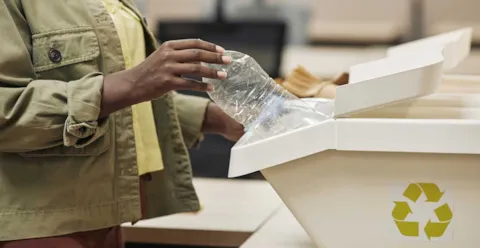We are in the beginning of the transition towards a circular economy. Unfortunately, we’re not moving fast enough.
Whether observing the global economy or specific companies and their activities, you see the same pattern: circularity is nascent and experimental in its implementation today and our circular performance validates that. At only 8.6% circular today, we have a long way to go as society, government and business to establish an economy that no longer depends on limitless resource extraction and dumping.
Demonstrating reasonable awareness of where general business stand in their circular transitions, only 7.8% respondents indicated that their company were leading in their circularity maturity.
So how do we get more companies to maturity in their circular ambitions and actions?
Circular Maturity Curve for Companies
In 2018 WBCSD and BCG published The New Big Circle, which identified three categories of innovation that companies adopt in transitioning towards a circular economy:
- Process innovation: the development and implementation of new or significantly improved production, logistic or recycling methods. Resource recovery is the most frequently cited circular business model in this innovation category.
- Product innovation: the development and introduction of new or significantly improved goods or services. Product life extension and circular supply are the most associated circular business models with this innovation category.
- Business model innovation: the development and implementation of a new logic in how the company creates value. Product-as-a-service (PaaS) and sharing platforms are the relevant circular business models in this category.
Each type of innovation entails greater complexity in its adoption as more stakeholder alignment and change are required. Neither of which should be underestimated in time and effort required to achieve. Companies should expect to expand their circular innovation from process to process and product, eventually taking actions across all three circular innovation categories.
As a company grows along the circularity maturity curve, circularity goes from a sustainability strategy to a business strategy. Eventually, circular economy becomes part of everyone’s responsibilities. As this occurs, more external coordination and collaboration is needed. However, in the end the company will likely find that the customer repeatedly surfaces at the core of strategic circular discussions.
Figure 1 Circular Maturity Curve of a Typical Company. Adapted from WBCSD & BCG's The New Big Circle Report (2019)
Over the past few years, WBCSD has observed how companies have integrated circularity into their core business proposition over time through a series of actions, ambitions and allocations of responsibility. Figure 1, the Circular Maturity Curve here illustrates a general depiction of how a company’s maturity in the circular economy can evolve over time. The following section shares what takes place in each of the three innovation stages and how responsibility changes over time.
Step 1: Process Innovation
First, companies have typically started their circular journeys by focusing on process innovation or doing business more efficiently. These activities are consistent with survey outcomes showing “cost savings” as the primary driver (65.7%) of those considering circular economy strategies. Reducing waste to landfill or being more efficient in resource consumption will likely reduce costs, making process innovation relatively low-hanging fruit for a company.
Survey results showed that almost 40% of respondents already have resource recovery business models in place, the most of all business models, with another 33% companies planning resource recovers activities in the short to mid-term. This result is consistent with resource recovery being the most common business model in the first stage in a company’s circular maturity.
Process innovation activities typically overlap with sustainability initiatives, such as zero waste to landfill or recycling targets and thus circular economy often finds a home with the sustainability team. As a result, it’s unsurprising that over half of the companies that have considered circular economy strategies identify “support and enhance sustainability strategies” as the second most important value driver.
Step 2: Product Innovation
As company leadership recognizes the potential of circularity on the business – and not just the sustainability department – ambitions grow, and circular activities require more investment. This is reflected in targets like increasing “circular materials” or improving “product durability”, highlighting a shift from improving operational processes to product innovation. Actions in this category range from incorporating more recycled content into a product to redesigning that product from the beginning to enable it to be repaired or refurbished after use.
Product life extension (30.3%) and circular supply (22.6%) are the second and third most adopted circular business models. Notably, 34% and 41% of respondents, respectively, indicated that they plan to adopt those circular business models in the short to midterm.
Product innovation begins to integrate circularity into the business strategy as it moves beyond operations cost reductions and financial gains into affecting the cost of goods sold or product margins. Consequently, this requires more buy-in from leadership and departments across the company, potentially including design, procurement, manufacturing, marketing and supply chain.
Step 3: Business Model Innovation
The third phase of a company’s circular maturity is characterized by its focus on circular business model innovation. As leadership fully integrates circularity into its core business strategy, it truly reevaluates how it can decouple business performance from linear resource consumption. Circular ambitions center around adopting PaaS or sharing platform business models. PaaS (17.6%) and sharing platforms (12.5%) were the bottom two most frequently adopted circular business models by survey respondents, consistent with the complexity in implementation.
Only 12.5% of those surveyed indicated that their company puts circularity at the core of their business strategy. At this level of maturity, circularity is fully integrated into all aspects of the business. It is a regular board room discussion, potentially affecting executive compensation and performance assessments. Design and R&D shape their innovation around circularity and life cycle thinking. Finance and accounting are fluent in circular business models, leveraging the mechanics of how those business models affect cash flows and balance statements. Fully mature circular businesses understand quantitatively how the company and its product portfolio perform with respect to circularity, have established their baseline from which to show improvement over time, and understand the risks and opportunities coming from it. The company then accounts for linear risks identified in their Enterprise Risk Management process.
Author: Brendan Edgerton - Director, Circular Economy, WBCSD

General insights
Read more on the general insights

Leaders' insights
Read more on the Leaders: impact and approach

Barriers and benefits of circular economy models
Transitioning toward circular economy will transform the way we design, market, use and dispose of products

No strategy without targets
Read more on the Circular Metrics Landscape Analysis published by WBCSD
